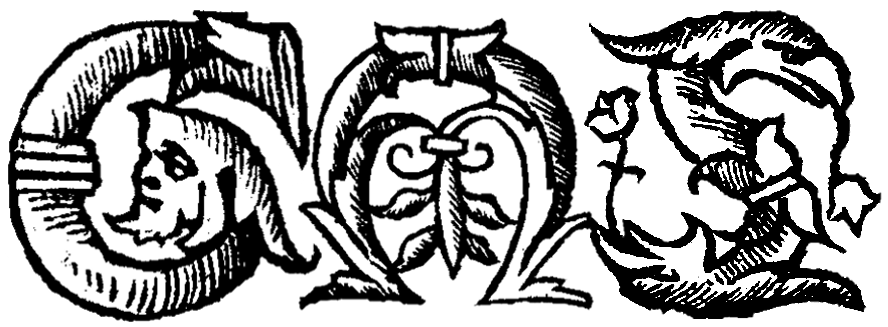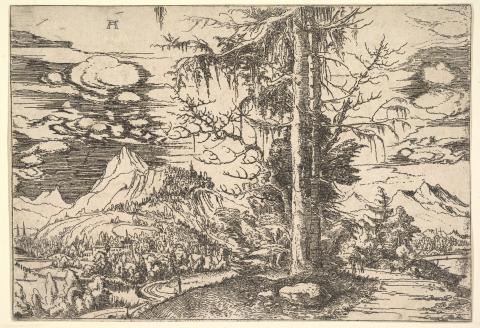Of the names of the Prussian false gods | Vonn dem namen der Preuschen abgöttir
Introduction to the Text
This text is an excerpt from Simon Grunau’s Preussische Chronik, or Prussian Chronicle. The text is written in the Early New High German language (Frühneuhochdeutsch), and scholars believe that it was completed by around 1530. It was composed in Prussia (which today spans northern Poland and Russia’s Kaliningrad Oblast), most likely in the vicinity of Gdańsk.
Little is known about the author Simon Grunau. He was a Dominican friar, born in Tolkmitsk in Prussia (which is near today’s Elbląg, Poland). He seems to have lived most of his life in Gdańsk, where he was particularly active preaching amongst the burghers. At the time when Grunau was writing, the position of the Dominican Order in Prussia was uncertain, not least due to the spread of Lutheranism across Prussia during the 1520s. The Lutheran Reformation had quickly reached and taken hold in Prussia, and this was a key concern for Grunau, not only due to Luther’s rejection of papal authority and monasticism, but also the social and doctrinal changes emerging as a result of Luther’s confrontation with the Catholic Church. In 1525, the Teutonic Order, the religious military order who had governed the majority of Prussia since the mid-thirteenth century, converted to Lutheranism and transformed their Catholic monastic state into a secular Lutheran Duchy. The impacts of these events are reflected in Grunau’s chronicle, highlighted by his open hostility to both Lutheranism and Duke Albert of Prussia (the first Duke of Prussia, and previous Grandmaster (leader) of the Teutonic Order).
Grunau’s chronicle purports to give an account of the history of Prussia from the beginning of time until around 1530, and as such contains a wide variety of socioeconomic, religious and political narratives. In addition to exploring the pre-Christian lives of the Prussians and the religious changes mentioned above, Grunau interweaves passages concerning economic themes such as taxation and price and currency fluctuations, as well as political themes such as relations between Prussia, Poland and the Holy Roman Empire.
The chronicle is a compilation of material from numerous sources, both narrative (other chronicles such as that of Peter von Dusburg) and documentary (such as the Treaty of Christburg, a legal and peace agreement between the Teutonic Order and Prussian tribes), as well as Grunau’s own experiences and material likely invented or seriously embellished by Grunau himself. As a result, its reliability and veracity are in question, and Grunau’s chronicle has often been wrongly dismissed as unworthy of study for this reason. There are numerous lines of enquiry still open with Grunau’s work, not least with respect to why and how he embellished his material, and what new narratives and identities he created in doing so.
The excerpt included in the Global Medieval Sourcebook is an interesting account of the supposed pantheon of gods worshipped by the pre-Christian Prussians before the thirteenth century, combined with details of how they came to be deified and what exactly their worship entailed. Within this there are several elements: first, the obviously ritualistic elements of the “pagan” worship of these gods, with gruesome sacrifice and quasi-ghostlike hauntings; second, the more worldly offerings Grunau suggests (such as various crops and animals), providing information about food and drink either found in Prussia or commonly known to his readers at the time. Finally, Grunau explores the foundation mythology of the Prussian people (the “Cimbri” and “Bruteni”), in attempts to reimagine Prussian identity and heritage in a period of intense conflict and division. It is this external imagining of a different religion and culture which is most interesting, and the way in which Grunau uses it to delineate a Prussian identity. These are themes which are still incredibly relevant today. By studying embellished or imagined narratives, we can better understand the agendas of those writing them.
About this Edition
The printed edition from which this translation has been produced is a critical composition of several manuscripts of Grunau’s chronicle, some of which are no longer extant. Trust has been placed in the edition, due to both the editorial methods employed, and comparison with a sixteenth century copy of the autograph manuscript for fidelity. The use of multiple manuscript copies for the edition provides more confidence with regards to copying errors, and where inconsistencies between the manuscripts appear, editorial footnotes have been made. There are around ten remaining copies or partial copies of the manuscript, although the autograph manuscript is believed to have been lost when Königsberg State and University Library was destroyed during the Second World War. The number of copies and their varied locations (including Stockholm, Toruń, Berlin, Dresden, Vilnius and Gdańsk) is suggestive of a broad textual transmission, and there were claims that Grunau’s narratives were still widely circulating into the nineteenth century.
For the translation itself several dictionaries were consulted, such as the Frühneuhochdeutsches Wörterbuch by Oskar Reichmann and the Kleines Frühneuhochdeutsches Wörterbuch by Christa Baufeld. To maintain fidelity with the original, proper nouns have remained untranslated and with their original spellings, and where possible syntax has been preserved; occasionally it was necessary to modify this to make the English translation more readable.
Further Reading
Bojtar, E., Foreword to the past: A Cultural History of the Baltic People. Translated by S. Rédet and M. Webb, Central European UP, 2000.
- A comprehensive approach to the language, origin and mythology of the Baltic people (although his argument is unfairly dismissive of Grunau).
Christiansen, E. The Northern Crusades. 2nd edition, Penguin, 1997.
- A general history of the period and region.
Verbeke, W., L. Milis, and J. Goossens. Medieval narrative sources: A gateway into the medieval mind, Leuven UP, 2005.
- This collection of essays provides an excellent discussion of fact and fiction in medieval narrative sources.
von Jeroschin, Nicholaus. The Chronicle of Prussia: A History of the Teutonic Knights in Prussia 1190-1331. Translated by Mary Fischer, Routledge, 2010.
- For an accessible chronicle of the history of Prussia, this translation of Nicolaus von Jeroschin’s work by Mary Fischer is essential.
Wadyl, S. “The sacred sphere of Prussian Life in the Early Middle Ages.” Sacred Space in the State of the Teutonic Order in Prussia, edited by J. Wenta, Nicholas Copernicus UP, 2013, pp. 39-54.
- A discussion of pre-Christian religious life in Prussia.
Credits
Transcription by Perlbach, M., Philippi, R., and Wagner, P., Duncker and HumblotTranslation by Thomas HewittEncoded in TEI P5 XML by Dante ZhuSuggested citation: Simon Grunau. "Of the names of the Prussian false gods." Trans. Thomas Hewitt. Global Medieval Sourcebook. http://sourcebook.stanford.edu/text/names-prussian-false-gods. Retrieved on April 25, 2024.

